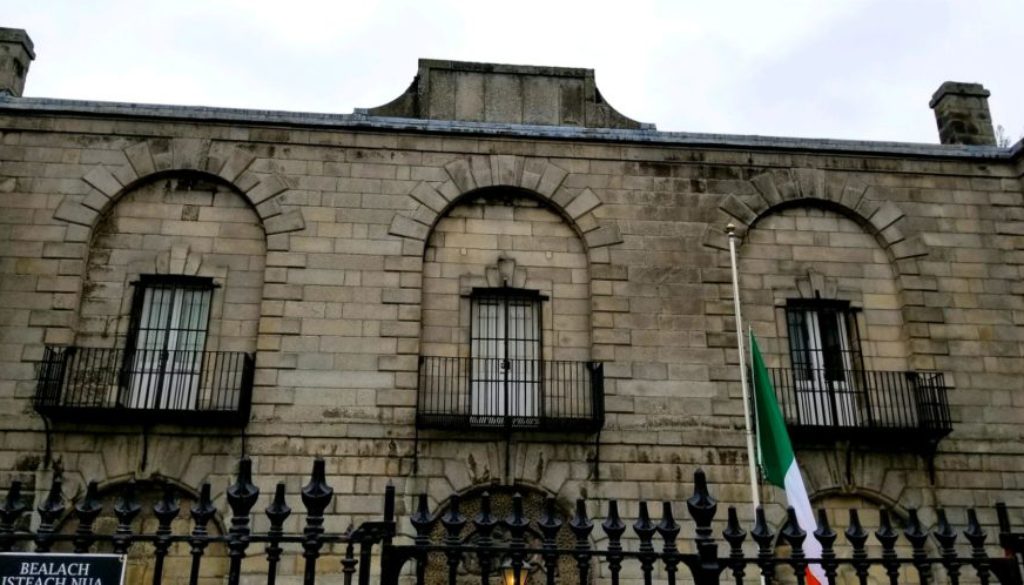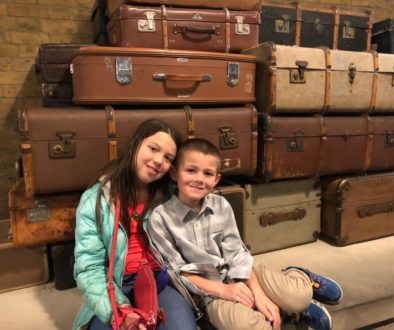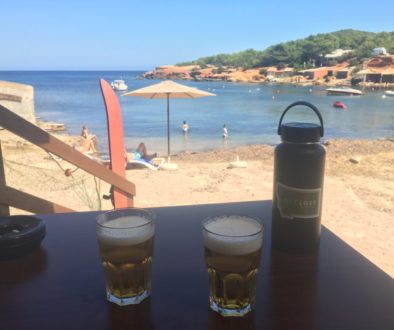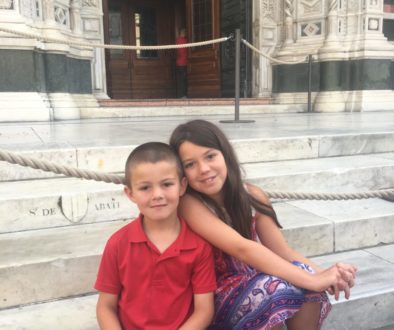Lessons From Jail
As we frantically board Dublin’s Hop On Hop Off bus I check the map again to see how many stops until our hotel. I had no idea that our family was about to end up in the local jail. The famed Kilmainham Gaol, to be exact. I checked my watch. We were running out of time. The bus was due to retire for the evening soon. Ten stops to go.
A jiggling in the seat across from me caught my eye. Oh no. “Are you kidding me?!” I screeched. “I just asked you if you needed to use the bathroom five minutes ago!”
“I can wait,” she says sheepishly. One look at her tells me that is not true.
As I start on my standard mommy rant about personal care and the general consequences of not listening to your mother, Kevin walks up to the bus driver to ask about public restrooms in the area. We had found that many restrooms throughout Europe required payment for use and I am scrambling to find any coins at the bottom of my purse to no avail. The driver points to a large building and assures us another bus will be by in 15 minutes.
My face red with anger I declare, “We are ALL going to use the bathroom whether you think you need to or not. And quickly! So help me if we miss that bus!”
The gentleman at the door asks for tickets and Kevin explains that we do not have any but are desperately in need of a restroom. The man looks at my dancing daughter. He points up the stairs and tells us to return to him as quickly as possible. His wording ‘as quickly as possible’ made me wonder if he could get in trouble for letting us in without a ticket.
We literally raced up the stairs. If there was a medal for Family Speed Peeing, that baby would be ours! Scrambling quickly down the stairs we make our way towards the exit when the gentleman stops us and hands us four initialed receipts. “It just started and some people didn’t show up. My associate is coming to collect you now and take you to join.”
As we are being whisked away I turn to my husband and whisper in confusion, “Where are we? A museum?” He shrugs. The kids look concerned. “We are going to miss the bus,” our seven-year-old son anxiously announces.
I look into my husband’s eyes for a moment for confirmation and smile. “Yes, we are.” He adds, “Don’t worry. We will figure that out later.” I squeeze his hand knowingly. Our family decided on adventure months ago and an unexpected opportunity just presented itself. There was no way we were going to pass this up.
Kilmainham Gaol ( pronounced Kill-main-ham Jail)
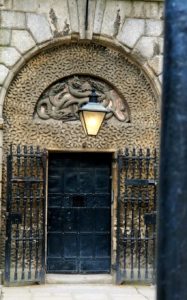
We found ourselves sitting in a tiny prison chapel and being transported back in time by the lilted voice of our Irish guide. She explained the significance of the jail and how it played a major role in Ireland’s story of independence.
Kilmainham Gaol was built in 1796 to replace the old dungeon-like prison located just a few hundred meters away. It was the first of it’s kind. It offered single-person cells which were new concepts at the time.
As we were guided down a narrow, dark hallway the tour guide opened a cell to let us see inside. My son was almost giddy with excitement. “We get to go inside?!” He asks. My shoulder brushes against the wall and tiny crumbles of limestone hit the floor. Suddenly I was more alert. We were standing in a piece of history. “Don’t touch anything!” I hissed at him. “Yeah, I know,” he says, annoyed.
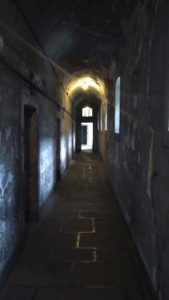
Spooky, cold and very dark
As we peered inside I tried to imagine surviving in this place. I don’t feel like I suffer from claustrophobia but it suddenly seemed harder to breathe. A tiny window at the top allowed very little light but would have been plenty big enough to let in the windchill and rain. The limestone surfaces were sure to provide a torturously damp and perpetually cold environment. Each prisoner was given a single candle for light and warmth and was advised to ration it for the following two weeks. My mind went back to all the times my husband had jokingly instructed me to light a candle to warm up on chilly nights. These poor souls really did that.
Times in Ireland became increasingly difficult and the cells that were designed to house 1 person quickly became home to 5 or 6 men, women, and children. Yes, CHILDREN! Our guide informed us children as young as 5 years old were detained here. Mostly due to stealing food but some for just being a nuisance. One boy was supposedly detained for playing marbles on a train and annoying other passengers. To this news, I gave my son a playful nudge and wink. He looks skeptical but seems to be minding his manners. He scoots a little closer to the exit.
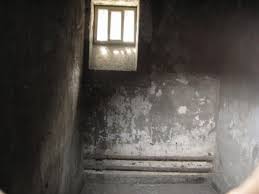
So cold!
The tour guide goes on to tell us that during the Great Famine, people were purposely committing crimes so they, too, could be imprisoned. The jail was so overwhelmed with prisoners that it resorted to housing them in the hallways. I don’t think I can adequately describe just how terrible it would be to be confined inside this place. It’s unimaginable to think that life was so dire outside these walls that people actually preferred these abhorrent conditions.
A new wing is eventually added and, fortunately for the inmates, limestone is not the building material chosen. The panopticon design is more like the prisons we see today on television. A large oval room with three floors of tiny cells around the edges and a central staircase with catwalks to each floor. The ceiling was glass which allowed light and warmth to enter but not the rain or cutting wind. In comparison to the original, this addition is luxury living! Except for its tiny rooms, no heat, no beds, and, oh yeah, you’re still in prison.
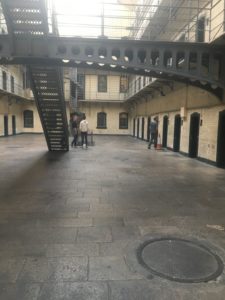
Food from the kitchen was brought up through the manhole.
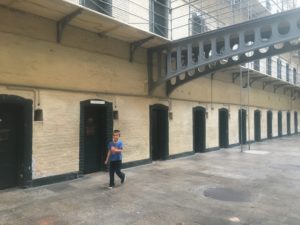
He loved running around and checking out all the cells
Our guide told us delightful stories about some of the occupants of Kilmainham Gaol during the quest for Irish Independence. The kids were astonished to learn of people like Constance Markievicz. While there were many women assisting in the rebellion and imprisoned, she was the only female prisoner to have been put into solitary confinement and sentenced to death. She was later granted mercy “solely and only on account of her sex”. She is said to have been so upset by this ruling that she screamed at her captors, “I do wish your lot had the decency to shoot me”.
Upon hearing this my daughter looks up at me, “They wouldn’t execute her just because she was a girl?! That’s not fair.” I glance at her a bit conflicted. Should I feel pride that she sees this as injustice? Yes, yes I should. I suddenly feel more hope for the next generation. Equality is not always ‘pretty’, it’s just equal. She already inherently gets that.
After Irish independence was achieved, Constance Markievicz did go on to fight another day and held a few different roles in the new Irish parliament.
Our tour guide explains the Easter Rising of 1916 and how the rebellion leaders were brought here to be executed for treason. Up until that point, the public did not have much sympathy for the rebellion’s cause to become an independent country. These rebels were actually spat on in the streets by their countrymen. Fifteen men were brought in front of a firing squad that week. One rebel leader, who was already dying rather rapidly from rebellion injuries was even strapped to a chair since he couldn’t stand, and executed via firing squad as well. The British were trying to send a message to all future rebels.
After hearing the news of the executions and stories of the leaders willing to die for their country, a spark was ignited and the public opinion began to change. The people of Ireland began to rally around the fight for independence and achieved it a few years later. The rebel leaders were hailed as martyrs and the remaining prisoners were given a heroes’ welcome upon their release.
I admit that we did not know anything about the history of Irish Independence prior to this unexpected tour. As an American, I am well aware of our country’s fight for independence from Britain. As patriots, we tend to reference our forefathers’ vision for our country 240 years ago (mostly when trying to win arguments on social media). I admit that I never really considered other countries celebrating virtually the same feat. Of course, I knew that Britain used to control many countries at one point, including Ireland, but hearing the stories of the rebels fighting for their freedom and seeing the conditions of their detainment makes history so much more personal and relevant.
Kilmainham Gaol is now considered one of the most important monuments in relation to the Irish struggle for independence.
As we wrap up our tour near the prison yard where the executions took place I feel myself getting a little emotional. These rebels were everyday people. They were not lobbyists. They were not large businesses or bureaucrats. They were overwhelmingly teachers, poets, journalists, playwrights, and historians who were passionate about making their country a better place for the people who lived there. History had proven that Britain did not have their country’s best interest at heart. Great Famine, anyone?
I pinch myself hard to prevent my tears from overflowing. We are both countries made from the determination of rebels. We must never forget that. We must never see a terrible injustice and say, “Well, it is what it is. Live with it. Accept it. Get over it.” We just can’t be complacent in that way.
Afterall, we are raising the next generation of rebels and the world is still full of unacceptable injustices to be challenged. Our heroes should be the ones that ignore the risk and speak out anyway.
I hug my daughter closer and emphatically thank the kind gentlemen at the door for giving us the tickets.
“So, it’s not so terrible that I needed to go to the bathroom now?” My daughter asks.
“Not at all,” I breathe. “The timing was perfect. I’m sorry.”
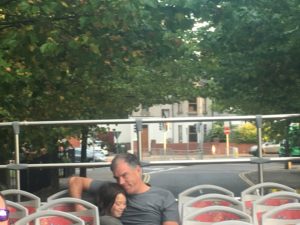
We even caught the bus home! It was MY timing that was off (didn’t adjust my watch to new time zone).
